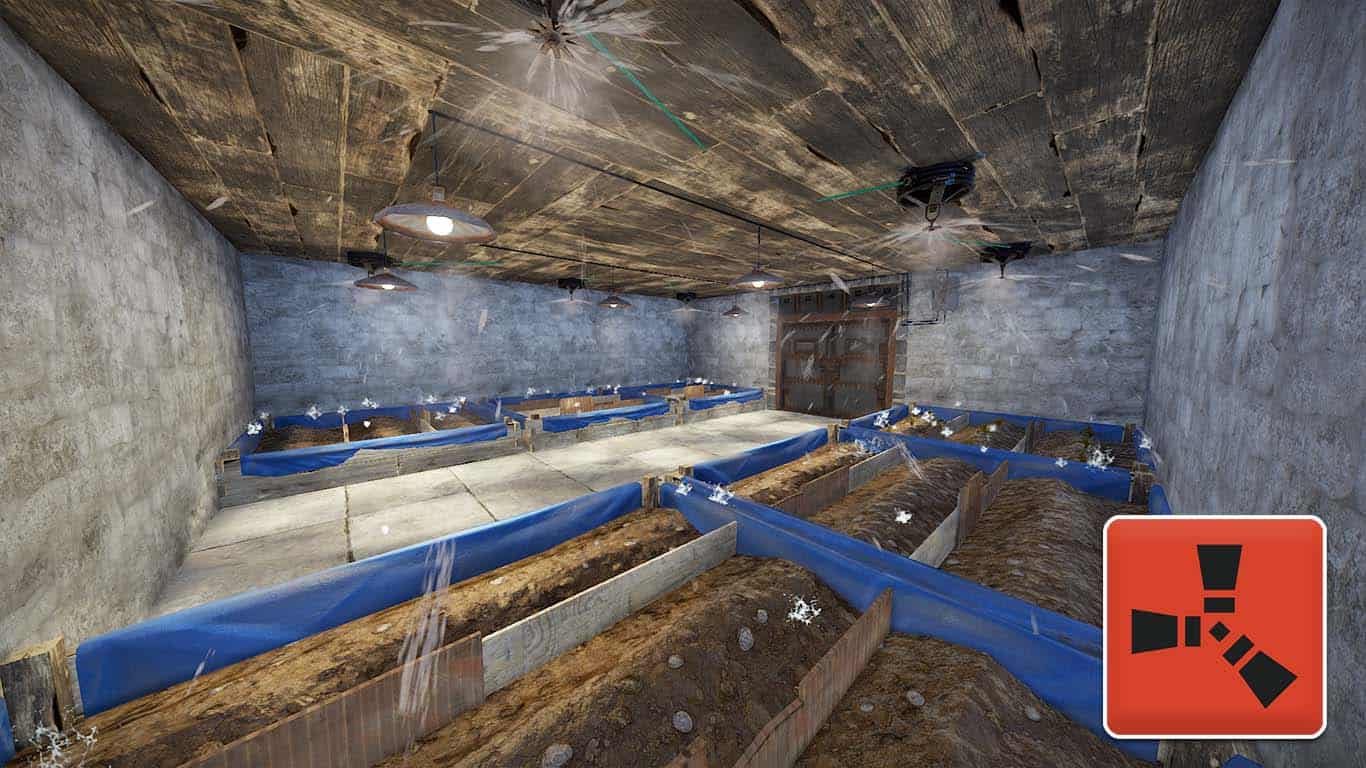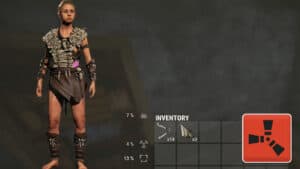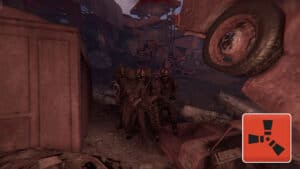One of the most important and profitable tasks in Rust is farming. You can gain some of the best food in the game by just taking care of some crops, and you can also sell them for a lot of scraps.
Farming, unfortunately, is not an easy thing for beginners, and you will need to learn about how plants work in Rust to properly raise good crops.
Recommended Read: Rust – Electricity System Guide
Crops will need light, water, fertilizer, and higher temperatures to work properly. But these things are not that easy to provide.
In this guide, we will go through everything you need to know about farming in Rust to successfully grow good crops every time you plant something.
Table of Contents
- How to Farm Crops in Rust
- Rust Farm Crops Conditions and Stats Explained
- How Composting and Soil Quality Works in Rust
- Rust Plant Genes Explained
- How to Crossbreed Plants’ Genes in Rust
- What Plants Should You Grow in Rust
How to Farm Crops in Rust
To plant crops and farm them in Rust, you will just need a place where to put down seeds. You can either do this outside, on normal ground, or on a planter box.
Planter boxes are really good if you want to create indoor farms and don’t want to risk other players stealing your hard work. However, outside farms are much easier to handle since they don’t really require any effort from you.
To get seeds and plant them in Rust, you can usually just eat vegetables like corn or pumpkins and get their seeds afterward. All plantable crops leave behind seeds when you eat them, allowing you to grow more and more.
The exact plants that you can grow in a planter box are corn, pumpkins, berries, hemp, and potatoes.
In general, if you have crops in a planter in Rust, all you need to do to raise and farm them is give them water, light, fertilizer, and heat. Depending on the location of your base, this can either be incredibly hard or easy.
The best places to farm crops in Rust are rivers in desert biomes. Rivers are a great source of constant water, and the desert has the perfect temperature in the morning for plant growth.
Rust Farm Crops Conditions and Stats Explained
After you’ve planted some crop seeds in your planter box in Rust, you will see some weird stats and growth requirements if you hover over them.
The first thing that you will see is genetics. We will explain those better a bit further in the guide. For now, let’s see all the other stats:
- Health – A number from 0 to 100 which tells you if the crop is about to die or not. If its health reaches 0, then the plant will die.
- Age – The stat shows you how long it has been since you planted the crop.
- Stage – The stage stat will tell you how long you have until the plant fully grows, from 0 to 100%.
- Water Intake – This stat will help you know how much water you have given the crop.
- Yield – The number of resources you will gain when you harvest a plant.
However, that part isn’t usually as important though as the conditions that the plant needs to meet to survive. If even one of these is having underwhelming results, then the plant will suffer overall from that one condition, losing health and even dying.
Light
Light can come from either the sun or from artificial lights. The sun can only provide sun during the morning, while ceiling lights can keep this condition at 100% all the time.
So, to keep the light condition at 100% you will need to place ceiling lights over your planter boxes. They don’t need to be placed perfectly over the box, but close enough to get all the plants.
Water
Water is the most complicated condition to meet since the water system is relatively hard to understand.
The best way to understand the water requirement is that if you don’t have a base next to a river, swamp, or the ocean, then don’t farm crops in Rust.
There are some special items that can help you get water even if you aren’t situated next to a body of water but those are too weak to fulfill the water needs of a full planter box.
Even if you built 20 small water collectors on your roof and connected them to your sprinklers, your plants would still die from a lack of water.
So, if you can’t use a water pump to get water from somewhere, then don’t bother with farming. But, if you really want to, you can try to collect water yourself and throw it over the planter boxes.
Another thing that you should know about the water condition is that you can also go over 100%, which will cause the condition to fall back below 100%. So, try to give your plants just enough water because you can drown them.
Ground
The ground condition represents the quality of the ground the crop is planted in. To increase this stat, all you need to do is place fertilizer inside the planter box.
However, be careful since the plants will eat the fertilizer very fast. Usually, this is one of the easier conditions to meet for crop growth in Rust.
Temperature
Temperature is only decided by the biome that you have your planter box placed in. At night, no matter what biome you are living in, plants will only get up to 25% temperature.
The arctic biome will always be stuck at 25%, even during the day. The forest biome will be somewhere around 70 to 90% at day, sometimes even reaching 100%. However, the desert biome will always have 100% during the day.
This is why you should usually only make crop farms in desert biomes close to bodies of water. Also, heaters don’t have any effects on plants.
Overall
This will be the total condition result. If one single condition (for example, temperature) is at a lower number, then the overall condition will have the same number as that one.
This means that if you can’t hold most of the conditions at around 100%, then your crops will always grow really slowly and will usually not be worth it.
How Composting and Soil Quality Works in Rust
One of the most important things when raising crops in Rust is fertilizer. You will need it to keep the ground condition (soil quality) up.
This is why the composter will be one of your best friends. The composter can be crafted using just 2 tarps and 200 wood, and it will allow you to turn horse dung and various other foods into fertilizer.
Since horses are relatively easy to acquire and you can use them as endless dung farms if you have enough food for them, then you can make a lot of fertilizer at the composter. One single piece of horse dung is enough to make you 10 fertilizer.
You can also place food inside the composter to make fertilizer, but the yield is much lower. Some of the best items you can place inside, besides the horse dung, are fish.
The composter works exactly the same as a furnace, which means that you should split the items that you are putting inside for maximum efficiency.
Place that fertilizer inside your planter box, and the ground (soil quality) condition will go right up. You will need to place a lot of fertilizer to make sure that the stat doesn’t go down any time soon.
Rust Plant Genes Explained
The last thing that you should know before going into farming in Rust is the plant genes. When you look at one of the crops you have planted, the first thing you will see are the genes.
These will be a string of 6 letters that will either improve your crop or make it worse. If a letter is surrounded by a green circle, then that gene is good, and red means that the gene is bad. Here is what every plant gene means in Rust:
- G – The green G stands for growth rate. One of these genes will speed up how fast the crop will yield results.
- H – The green H stands for hardiness. If a plant has a hardiness gene then it can resist in worse weather and will also yield results with more health and food recovery.
- W – The red W stands for water intake. A W gene will increase the amount of water that a crop needs to reach 100%.
- X – The red X stands for nothing. This gene just means that you didn’t get anything interesting.
- Y – The green Y stands for yield. This gene will increase the number of resources a crop will give you when you harvest it.
Many players consider that only the G and Y genes are useful since the H gene doesn’t give incredible results.
The best way to make sure that the crop you are planting has the best genes is to plant the crop and destroy it until you get a good genetic result.
The best gene compositions that your crops can have in Rust are ones that only have G and Y genes. So, either GGYYYY, GGGYYY, or GGGGYY. The exact order of the genes that you see when you look at the plant doesn’t matter.
Usually, you would do your best to raise one or two crops with perfect genes, and then you can crossbreed perfect crops.
How to Crossbreed Plants’ Genes in Rust
Imagine you have a large planter box with 9 slots for seeds. Now, if you place 6 identical seeds (same type of plant) in the box, they will influence each other’s genes.
Most plants will have either 3, 5, or 8 other seeds adjacent to them. So, the corner plants will have 3 neighbors, side plants will have 5, and the one in the middle will have 8.
Each neighbor of a plant will influence each other’s genes. For example, let’s talk about a planter box that only has 4 slots filled, the corner slot, the two side slots next to it, and the center slot.
Let’s assume the genes of the plant in the corner is just G’s. If two of its neighbors have 2 Y genes in the second slot of the gene system, then the corner plant’s second gene will also change to Y.
So, if two neighbors have the same green genes in the same slot on the gene system, they will also replace it for the corner plant. If only one of them has a red gene, they will most likely override the good genes from the corner plant.
The conclusion is that it can be very hard to crossbreed plants in Rust. However, players can clone plants to only get good genes and never have to mess too much with this complicated system.
Raise 4 identical crops, each one planted in the corners of a large planter box. This way, they won’t affect each other. Make sure that you have a lot of seeds and plant them and remove them until you only have perfect genes.
Once they’re raised, instead of harvesting them, hold down E and select the “Clone” option. You will now be able to use these clones to raise only high quality crops each time you plant something. Just make sure that every time you harvest them, you also clone the corner slots.
What Plants Should You Grow in Rust
If you are growing any type of plant besides hemp in Rust, then you don’t need to worry about genes and other complicated stuff.
In general, you shouldn’t grow anything else besides hemp, as it is the only crop that can help you long-term. Maybe also one large planter box with pumpkins should be enough to keep your base fed.
That’s everything you need to know about farming in Rust!
Have any input or suggestions for this guide? Let us know in the comment section below.





Forest biome is the best for growing, and yes heaters very much do affect temperature of the plants. The desert is too cold for plants at night, but if you use heaters in desert during day, it’s too hot. In forest/green biome the plants don’t go down to 25% temperature, so even if you don’t have heaters in forest biome for night, they still grow faster than desert at night, but if you do use heaters, it’s not too hot during day.
i’ve farmed a few times without nearby water and it can be done with a sufficient number of water catchers. It’s also easy to setup a pump remotely and truck 200,000ml of water at a time back to where you’re growing. the best way to use water catchers for the task though is to have them dump into water barrels and as long as you keep your barrels full before you plant, you should have sufficient water to complete the cycle.
you say heaters dont effect crops but I’ve seen my crops temp state increase by just turning on a heater nearby. They absolutely do make a difference.